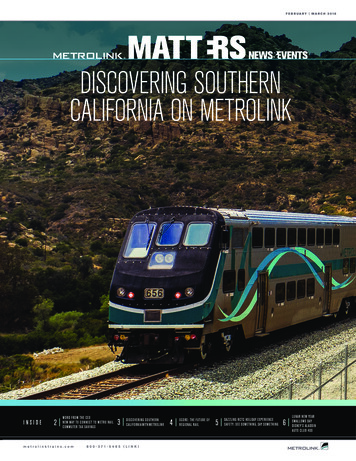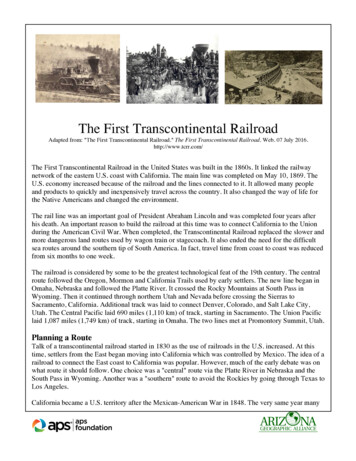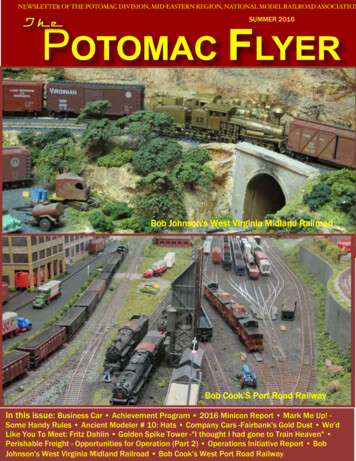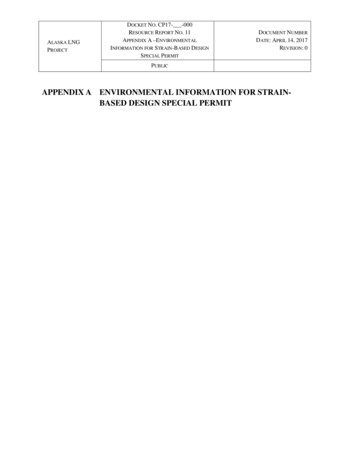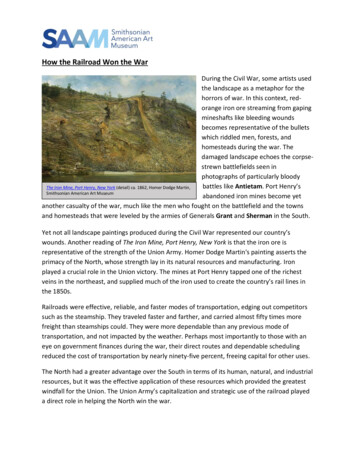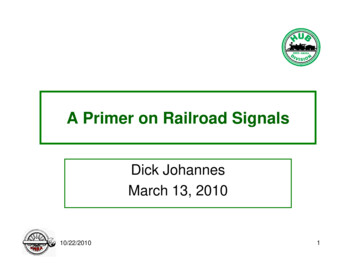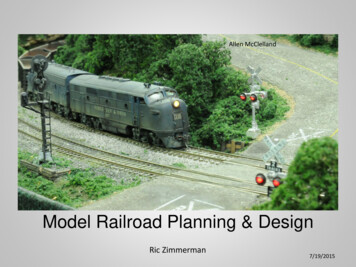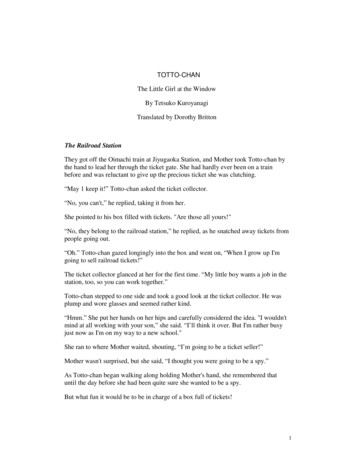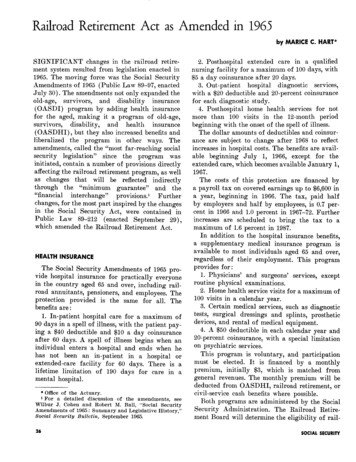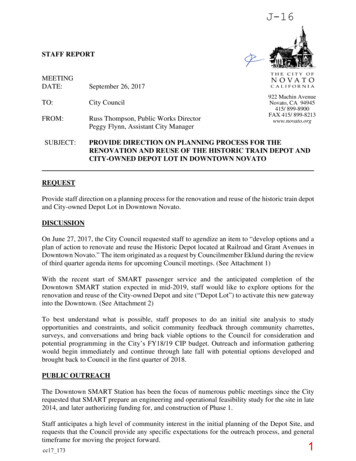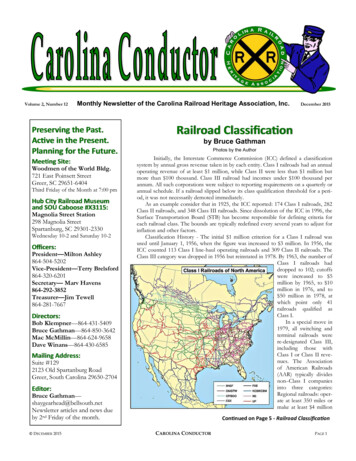
Transcription
Volume 2, Number 12Monthly Newsletter of the Carolina Railroad Heritage Association, Inc.Preserving the Past.Active in the Present.Planning for the Future.Meeting Site:Woodmen of the World Bldg.721 East Poinsett StreetGreer, SC 29651-6404Third Friday of the Month at 7:00 pmHub City Railroad Museumand SOU Caboose #X3115:Magnolia Street Station298 Magnolia StreetSpartanburg, SC 29301-2330Wednesday 10-2 and Saturday 10-2Officers:President—Milton Ashley864-504-5202Vice-President—Terry Brelsford864-320-6201Secretary— Marv Havens864-292-3852Treasurer—Jim Tewell864-281-7667Directors:Bob Klempner—864-431-5409Bruce Gathman—864-850-3642Mac McMillin—864-624-9658Dave Winans—864-430-6585Mailing Address:Suite #1292123 Old Spartanburg RoadGreer, South Carolina 29650-2704Editor:Bruce Gathman—shaygearhead@bellsouth.netNewsletter articles and news dueby 2nd Friday of the month. DECEMBER 2015December 2015Railroad Classificationby Bruce GathmanPhotos by the AuthorInitially, the Interstate Commerce Commission (ICC) defined a classificationsystem by annual gross revenue taken in by each entity. Class I railroads had an annualoperating revenue of at least 1 million, while Class II were less than 1 million butmore than 100 thousand. Class III railroad had incomes under 100 thousand perannum. All such corporations were subject to reporting requirements on a quarterly orannual schedule. If a railroad slipped below its class qualification threshold for a period, it was not necessarily demoted immediately.As an example consider that in 1925, the ICC reported: 174 Class I railroads, 282Class II railroads, and 348 Class III railroads. Since dissolution of the ICC in 1996, theSurface Transportation Board (STB) has become responsible for defining criteria foreach railroad class. The bounds are typically redefined every several years to adjust forinflation and other factors.Classification History - The initial 1 million criterion for a Class I railroad wasused until January 1, 1956, when the figure was increased to 3 million. In 1956, theICC counted 113 Class I line-haul operating railroads and 309 Class II railroads. TheClass III category was dropped in 1956 but reinstated in 1978. By 1963, the number ofClass I railroads haddropped to 102; cutoffswere increased to 5million by 1965, to 10million in 1976, and to 50 million in 1978, atwhich point only 41railroads qualified asClass I.In a special move in1979, all switching andterminal railroads werere-designated Class III,including those withClass I or Class II revenues. The Associationof American Railroads(AAR) typically dividesnon–Class I companiesinto three categories:Regional railroads: operate at least 350 miles ormake at least 4 millionContinued on Page 5 - Railroad ClassificationCAROLINA CONDUCTORPAGE 1
ArrivalsSouthern Museum ofCivil War andLocomotive HistoryThe Glover Machine Works:Casting a New South is an exhibitfeaturing the only fully restoredbelt-driven locomotive assembly line in the country.The Glover MachineWorks, originally located inMarietta, Georgia, played a significant role in industrializing Georgia after the Civil War by becomingthe largest locomotive builder in the South. Thisexhibit gives visitors a fascinating look at the original machining equipment and two restored Gloverlocomotives in various stages of assembly.An audio-visual presentation detailing the trainbuilding process from start to finish, helps visitorsexperience life as a factory worker while detailedcompany records provide insight into the manage- DECEMBER 2015ment of the Glover Machine Works.Experience this exhibit and you are sure to come awaywith a new appreciation for the industry that rebuilt thisarea after the Civil War and one of the more notable families that drove it.The Museum’s website at www.southernmuseum.org.CAROLINA CONDUCTORPAGE 2
DeparturesNS First Responders UnitNorfolk Southern #5642 poses outside the Juniata PaintShop in Altoona, Pennsylvania. The EMD GP38-2 hasbeen painted into a scheme similar to SD60E #9-1-1. NS#5642 will be assigned to the "Safety Train" which travelsthe NS system to provide training to first responders forrail-related incidents.EMD Tier 4 Demonstratorsroller bearing upgrades, brake rigging, brake shoes, sanding tubes,wheels and axle sets, D78 traction motors.The process was performed at the River Junction Shops onthe former Piedmont & Northern - the hub of the P&N's SouthCarolina Division in its day. Nostalgic for our locomotives withtheir herald to be where so much history took place.CP NS - Not Likely!EMD has released the first two SD70ACe-T4s from ProgressRail’s Muncie, Ind., plant for testing. EMDX Nos. 1502 and 1503departed Indiana enroute to the AAR Transportation TechnologyCenter near Pueblo, Colo.The SD70ACe-T4 is EMD's North American freight locomotive designed to meet Tier 4 emissions standards that took effectat the beginning of 2015.GRLW GP’s Get New TrucksGreenville & Western's veteran workhorses finally get put onthe surgeon's table to get some much needed attention. Both#3751 & #3752 were taken out of service some time back. Brandnew truck sets for both locomotives were recently received. Thenew truck sets include: truck frames, spring packs, leaf springs, DECEMBER 2015Norfolk Southern slammed the door on Canadian Pacific’smerger offer, calling it “grossly inadequate,” highly unlikely towin regulatory approval, and a bad fit that would put the combined railroads at a long-term disadvantage. “We believe in ourability to generate greater shareholder value through execution ofour strategy,” NS CEO James Squires said. And those regulatoryissues mean a CP-NS combination would never get out of thestarting gate, NS contends. “The hurdles are very, very significantto this proposed combination,” Squires says.The regulatory review process would take two years or more,putting NS in limbo and interrupting the railroad’s focus andmomentum, Squires says. Plus, the way CP wants to structure thedeal – with NS in a voting trust and CP management effectivelyin charge – would require two periods of public comment, withopposition expected from shippers, other railroads, labor, andcommunities.Wanted—Articles for the Carolina ConductorYou too can be famous! Submit an article of 100 words or moreand some photos and see them in print. Every one of us has someunique railroad experience that would make interesting readingfor our membership.CAROLINA CONDUCTORPAGE 3
Rare Mileage1950 Southern Railway Advertisement DECEMBER 2015CAROLINA CONDUCTORPAGE 4
ManifestContinued from Page 1 - Railroad ClassificationPacific RR, Kansas Cityper year. Local railroads: non-regional but engageSouthern de México,in line-haul service. Switching and terminal railwholly owned by KCSroads: mainly switch cars between other railroadsRwyor provide service from other lines to a commonClass II - A Class IIterminal.railroad hauls freight andClass I Criteria - In the United States, theis mid-sized in terms ofSurface Transportationoperating revenue. As ofBoard defines a Class I rail2011, a railroad withroad as "having annual carrirevenues greater thaner operating revenues of 250 million or more" afteradjusting for inflation usingthe Railroad Freight PriceIndex developed by theBureau of Labor Statistics.According to the Association of American Railroads,Class I railroads had aminimum carrier operating revenue of 346.8million in 2006, 359million in 2007, 401.4million in 2008, 378.8million in 2009, 398.7million in 2010 and 433.2 million in 2011.In early 1991, twoClass II railroads, Montana Rail Link and Wisconsin Central, askedAll five US owned Class One railroad’s werethe Interstate Comphotographed in the Upstate.merce Commission(ICC) to increase the minimum annual operating revenue criteria(then established at 93.5 million) to avoid being re-designated asClass I, which would have resulted in increased administrative and 37,400,000 but less than 433,200,000 for at least three conseculegal costs. The Class II maximum criterion was increased in 1992 tive years is considered Class II. Switching and terminal railroadsto 250 million annually, which resulted in the Florida East Coast are excluded from Class II status. Railroads considered by theRailway having its status changed to Class II. Rail carriers with less AAR as "regional railroads" are typically Class II.Current Class II Criteria - The last major change of the upperthan 20 million in revenue are designated as Class III. In Canada,a Class I rail carrier is defined as a company that has earned gross bound for a Class II railroad was in 1992, when the Florida Eastrevenues exceeding 250 million (CAD) for each of the previous Coast Railway was changed from a Class I railroad to Class II. Aprevious change in 1991, which prevented two railroads - Montanatwo years.Currently, eleven railroads in North America are designated as Rail Link and Wisconsin Central - from becoming Class I, wasClass I. In the United States, Amtrak and seven freight railroads made at the request of the two railroads, as they did not wish totake on the extra cost and paperwork associated with Class I staare designated Class I based on 2011 measurements released 2013.tus. Changes since then have been adjustments for inflation. Trackage only in Canada - Via RailA Class III or short-line railroad has annual operating revenue Trackage in both the United States and Canada - Amtrak,of less than 20 million (1991 dollars). Class III railroads are typiBNSFRwy, Canadian National Rwy, Canadian Pacificcally local short-line railroads serving a small number of towns andRwy, CSX Transportation, Norfolk Southern Rwyindustries or hauling cars for one or more larger railroads. Many Trackage only in the United States - Union Pacific RRClass III railroads were once branch lines of larger railroads or Trackage in both the United States and Mexico - Kansas City abandoned portions of main lines. Most Class III railroads areSouthern Rwy in Mexico via subsidiary KCS de Méxicoowned by railroad holding companies such as Genesee & Wyo Trackage only in Mexico - Ferromex, 26% owned by Union ming and Iowa Pacific Holdings. DECEMBER 2015CAROLINA CONDUCTORPAGE 5
Marker LightsSouth Carolina Short Line RailroadsThe following nine short line railroads, not including state owned lines, are located in South Carolina: Aiken Railway (AIKR), Carolina Southern Railroad (CALA), Carolina Piedmont Railroad (CPDR), Greenville & Western Railway (GRLW), Hampton and BranchvilleRailroad (HB), Lancaster and Chester Railway (LC), Pee Dee River Railway (PDRR), Pickens Railway (PKHP), South Carolina CentralRailroad (SCRF).CPDRCALAGRLWLCHBPKHPAIKRPDRRCheck out the CRHA on ourFacebook group.Check out the Museum on ourFacebook -Museumwww.facebook.com/pages/CRHAINC DECEMBER 2015CAROLINA CONDUCTORPAGE 6
million in 2006, 359 million in 2007, 401.4 million in 2008, 378.8 million in 2009, 398.7 million in 2010 and 433.2 million in 2011. In early 1991, two Class II railroads, Mon-tana Rail Link and Wis-consin Central, asked the Interstate Com-merce Commission (ICC) to increase the minimum annual operating revenue criteria
